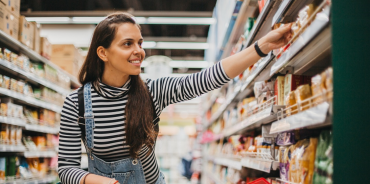Costs, the climate, and Customer First: our CPG trends for 2023
With the book now firmly closed on 2022, it’s time to look ahead to the next 12 months and what they might bring.
To find out what might be in store for the world’s consumer packaged goods (CPG) companies, we caught up with Sandrine Devy – head of dunnhumby’s global CPG practice. Here, Sandrine shares her thoughts on the challenges, opportunities, and overarching trends that are likely to lie ahead during 2023.
1. For most, staying in will (still) be the new going out
Covid had a gigantic impact on the world’s dining habits, with many people shifting from eating at restaurants to cooking at home. Post-pandemic, the assumption was that we’d see a return to how things used to be. After three “extraordinary” years, however – and with the cost of living continuing to rise – it’s likely that the cooking from scratch trend will continue apace.
For brands, that represents an extension of the significant commercial opportunity they saw during the pandemic, with shoppers looking for inspiration and fun in their weekly shop in lieu of being able to spend out elsewhere. Turning that opportunity into reality, though, will depend on a brand’s ability to navigate the next issue on this list…
2. Costs – and prices – will be in the spotlight
From energy to raw materials, manufacturing is becoming increasingly expensive; numbers from the Department of Agriculture suggest that food production costs rose by $66.2bn (18%) in the US alone during 2022, the biggest increase on record[1]. For CPGs, that presents a quandary as to whether to absorb those costs as best as possible, or pass them on at the shelf.
With consumer sensitivity about the cost of groceries continuing to rise, brands that choose the latter option are likely to be under growing pressure to show that they’re not simply profiteering from a cost of living crisis. Cost transparency could be a critical issue for the year ahead, CPGs needing to demonstrate that they’re doing everything they can to keep price rises away from their customers’ wallets.
3. Sustainability will become an even hotter topic
dunnhumby runs numerous consumer studies each year. In some of our most recent, we saw that while many shoppers would like to live a more sustainable lifestyle, they don’t feel that they can due to the costs associated with doing so. Just as the overall cost of goods is likely to come under greater scrutiny, consumer sentiment about being “priced out” of living responsibly may start to simmer over the course of the year.
It won’t just be shoppers that start to apply the pressure around sustainability, however. Carrefour’s very public announcement that it intends to delist any suppliers that aren’t meeting the goals of the Paris Agreement is likely to be the start of a more widespread retailer response. Just as scrutiny over profits may increase in 2023, expect to see retailers become much stricter about the environmental performance of their partners too.
4. Loyalty may wane in the face of hardship
Another issue that may further complicate the relationship between brands and retailers is the issue of private label. As shoppers continue to grapple with higher living costs, so too will the trend towards downtrading – with shoppers particularly likely to make the switch to private label products, as seen in one of our most recent Retailer Preference Index studies.
Private label won’t be the only competition that CPGs face in the year ahead, of course. Compounding the downtrading issue will be innovative start-ups, equipped with agile digital marketing capabilities and a laser-focus on upsetting the status quo. With those two factors working in tandem, all signs suggest that brands will have to work harder than ever to keep hold of their customers during 2023.
5. Data maturity hits the top of the to-do list
In the face of a situation like the one described above, data can be a key defensive measure – providing CPGs with a better understanding of customer needs (and how best to meet them). It’s with that in mind that I expect many brands to continue their investments into data and analytics capabilities over the next 12 months, building the momentum they need to turn information into insight.
Whether they’re procuring key personnel like data managers, scientists, and engineers, or simply investing in new sources of insight and bringing them into their decision making processes, achieving a new level of data maturity is sure to be high on the agenda for many brands. For an idea of what that might look like in practice, check out our respective trends posts on data and data science from my colleagues Alison and Sandra.
6. Product innovation may be the key to success
If there’s one thing that we can say with absolute certainty right now, it’s that consumer needs are changing fast. While that presents a range of insight-related challenges for CPGs to overcome, it also provides an opportunity to innovate around those new missions and ensure that those products on shelves are the ones that truly reflect what shoppers want.
Whether it's the creation of value-focused sub-brands, or simply smaller pack sizes for those on a budget, new product development could play a big role in CPG fortunes during 2023. The trick, as always, will be understanding which ideas resonate with which customers – and how best to communicate those concepts to the audiences in question.
[1] Cost of growing food in US set to rise by most ever in 2022 – Business Mirror, 2 September 2022
The latest insights from our experts around the world



